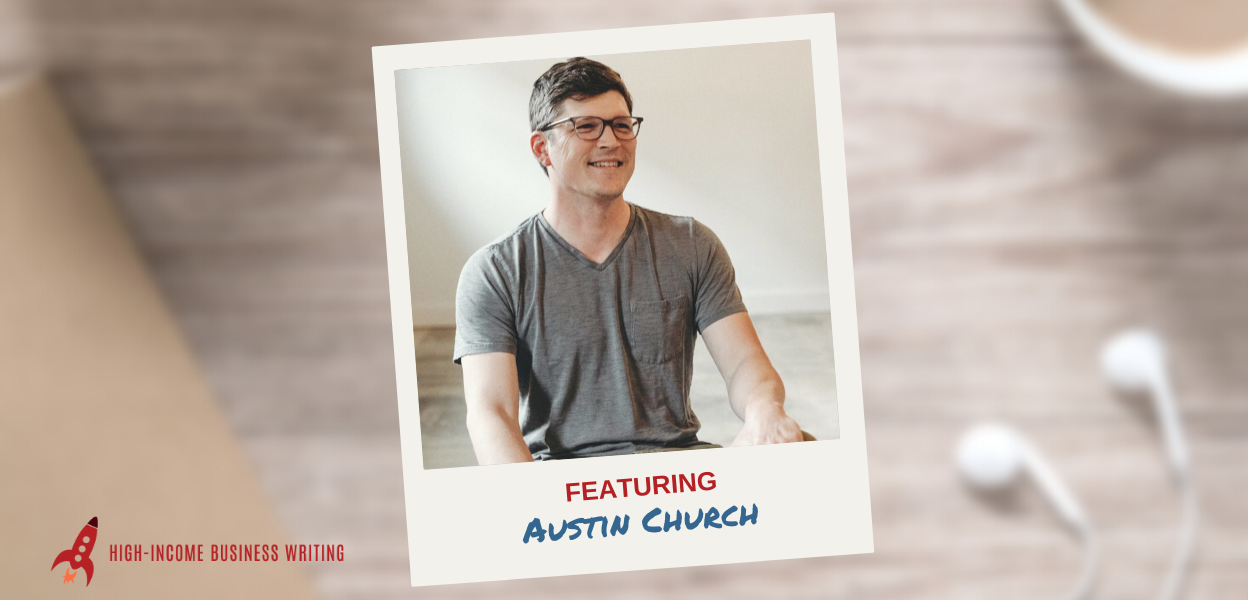The days of offering only writing services to your clients are numbered if you want to earn a six-figure income doing great work for great people.
It’s not that you’ll starve otherwise.
It’s just that you’ll find it progressively harder to earn a great living consistently.
If you want to do well in the future, you have to shift from being an order taker to being a trusted advisor.
Which is something my guest today knows firsthand.
Austin Church is the founder of Balernum—a branding and marketing firm that works with passionate and gutsy company founders to build brands people care about.
A few years ago, Austin shifted his business away from providing content to getting more deeply involved with clients.
The results have been nothing short of transformational for his business and clients.
In today’s podcast episode, you’ll hear how and why Austin transformed his business to make it more profitable—and fun.
The notes that follow are a very basic, unedited summary of the show. There’s a lot more detail in the audio version. You can listen to the show using the audio player below. Or you can subscribe in iTunes to get this show delivered straight to the Podcasts app on your smartphone, tablet or iPod.


High-Income Business Writing with Ed Gandia
#267: Austin Church on How and Why to Sell Strategy Engagements to Your Clients
Tell us a bit about yourself and your business
Austin L. Church is a writer, brand consultant, and online entrepreneur. He does a lot of work with brand strategy, content strategy, launch strategy and messaging strategy, as well as some boots-on-the-ground copywriting.
How did you get into this line of work?
He got a job as a copywriter/social media strategist/account executive at an agency and wrote everything under the sun.
He was laid off in April 2009 when the economy tanked. He’s been his own boss ever since.
How did you get into brand strategy?
When Austin started his own business, he was a run-of-the-mill writer charging $40 an hour.
A more senior copywriter told him he needed to raise his rates to $75 to be taken seriously.
He helped Austin understand there’s more to the business of writing than stringing together nice sentences. That set him on the path of dabbling in areas that held higher value for clients.
When did you start offering strategy as a standalone offering?
Clients would pull Austin into strategy discussions, and he came to realize that a lot of his clients had needs beyond writing.
Around the same time, Brennan Dunn’s podcast put him onto the idea of road mapping and asking good questions. Austin started being more consultative to facilitate the process of self-discovery.
By 2016, he was booking $500 road mapping sessions with clients.
Today, Austin calls these sessions wayfinding workshops, and they’re longer, deeper and more expensive.
How are you able to interest clients in this offering?
About seven out of 10 prospects don’t have a well-defined project.
Austin asks open-ended questions to find amorphous goals, most of them involving growth or greater efficiency or fewer headaches.
In the process of going deep on strategy, Austin can discern if there’s an opportunity to work together after the strategy session is complete.
How do you define strategy?
Strategy is the collection of decisions you’ll make to get from where you are to where you want to be.
It all starts with a goal. And a lot of clients don’t have clarity around their goals.
What does a typical strategy engagement involve?
Austin sends over a list of eight to 10 questions about their goals in advance. He tries to gather as much intel as possible beforehand—because he has a list of 20 to 30 questions he will draw from during the meeting itself.
He pulls more goals and objectives out of the client during the meeting, and these often come as a big surprise to the client.
These engagements usually last between 90 minutes and three hours, and Austin charges between $2500 and $3500.
Clients come away with an actionable plan with standalone value.
He starts by trying to understand the problem the client is truly trying to solve.
Once that’s revealed, he examines the various paths forward with the client.
After they’ve decided on a path, they put together a plan, including options for Austin’s ongoing involvement.
What other benefits do you see in these kinds of engagements?
Austin essentially gets paid to vet his clients through this process,
It also creates a safe space for clients to talk honestly about their goals and the value of the outcomes they want—setting everything up for value-based pricing.
Is there a type of client that’s a particularly good fit for this approach?
The process is particularly helpful for solo founders. They often don’t have a sounding board and, in the crush of trying to grow a business, they don’t take time to think and reflect.
A lot of the time, they’re paying Austin for self-reflection that’s guided by someone with an outside perspective who’s willing to be direct. It’s a type of business therapy.
Clients walk away with a deep well of confidence that comes from having clarity.
Are these standalone strategy engagements moneymakers or “loss leaders”?
Austin has raised the price proportionally over the years as he delivers more value. Even if it’s a three-hour workshop—and he needs an hour to prep and three hours to clean up—he still does well.
These sessions also establish him as a thought leader so he can charge more for other aspects of his business.
They also preempt a lot of the mistakes, headaches and frustration that can happen during implementation when the plan is not well defined.
How can writers start moving in this direction?
If you’re intrigued by strategy as a standalone offer, start to experiment.
Start collecting open-ended questions (Austin is willing to share his) and put an offer out there. Book a client and see if you like the process.
If you don’t, you can stop. If you do, ratchet up your rates over time and extend the duration of the session.
Writers who are charging premium prices may feel like piloting a new offer at a low price is a step backward. But it’s okay to experiment.
You don’t have to make a profit the first time around. At that stage, your goal isn’t to make a profit—it’s to find out if you like doing the work.
How can listeners learn more about you and your work?
Austin’s website: https://austinlchurch.com
Balernum: https://balernum.com
By the way… whenever you’re ready, here are 3 ways I can help you grow your freelance business:
1. Grab a free copy of my book.
It’s called Earn More in Less Time: The Proven Mindset, Strategies and Actions to Prosper as a Freelance Writer. The title says it all. 😉 — Click Here
2. Join my implementation program and be a case study.
I’m putting together a new implementation group this month. If you’re earning $5k+/month (or the part-time equivalent) from your freelance business … and you’d like to grow your income quickly with better clients … just email me at ed@b2blauncher.com
3. Work with me privately.
If you’re a 6-figure writer who’s trying to earn more in less time, with less stress, I might be able to help you get there faster than you think. Just email me at ed@b2blauncher.com and put “Breakthrough” in the subject line, and I’ll get back to you with more details.






